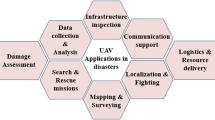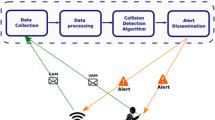Abstract
In vehicular ad-hoc network, vehicles are move very speedy thus their topology is changing frequently and intermittent connectivity occur often. The intermittent connectivity network (delay and disruption-tolerant network) resulting is end to end path is absent. In this intermittent network connectivity areas, during emergency event occurs, emergency rescue message (Example: Fire, Accident, etc.,) are sent to a rescue team is most necessary. Due to these constraints, general ad hoc protocol approaches is not suitable and, as a result, alternative protocol must be deliberated. This leads to the make a specific protocol mechanisms able to deliver both fast and trustworthiness in-order delivery emergency message needed. Thus we introduce the DFEMDR protocol, it follow the vehicular delay tolerant network (VDTN) common technique store carry-forward method and message replicas. This paper describes an efficient Delay tolerant Fast Emergency Message Dissemination Routing Protocol, called DFEMD routing protocol. This protocol enables in VDTN, the source node broadcast an emergency message to all available node in its communication range. The source node allocates a message replicas and message time to live to the neighbour nodes (forwarded node) based on that node has credence value. Credence value is calculated to all nodes based on two values; the first value is visited level estimation, it is calculated based on the number of nodes previously visited by the node. The second value is Destination Reaches Level Estimation (DLE); it is calculated based on the number of times the node successfully delivered the message to the destination. Finally, each node credence value is calculated, from this visited level and destination reaches level estimation values. Finally, the trust authority received emergency messages and evaluate the trustworthiness of message based on message reputation value or message confidence value.








Similar content being viewed by others
References
Alriyami, Q., Adnane, A., & Smith, A. K. (2014). Evaluation criterias for trust management in vehicular ad-hoc networks (VANETs). In: 2014 International Conference on Connected Vehicles and Expo, ICCVE 2014—Proceedings.
Anyigor Ogah, C. P., Cruickshank, H., Asuquo, P. M., Lei, A., & Sun, Z. (2017). Delay tolerant revocation scheme for delay tolerant VANETs (DTRvS). https://doi.org/10.1007/978-3-319-67639-5.
Burgess, J., Gallagher, B., Jensen, D., & Levine, B.-N. (2006). MaxProp: Routing for vehicle-based disruption-tolerant networks. In Proceedings IEEE INFOCOM. 25TH IEEE International Conference on Computer Communications, Barcelona, Spain (vol. 6, no. c, pp. 1–11).
Chen, Y.-M., & Wei, Y.-C. (2013). A beacon-based trust management system for enhancing user centric location privacy in VANETs. Journal of Communication Network, 15(2), 153–163.
Ding, Q., Li, X., Jiang, M., & Zhou, X. (2010). Reputation-based in vehicular trust model ad hoc networks. In International Conference On Wireless Communications and Signal Processing (WCSP). IEEE, Suzhou, China (pp. 1–6).
Fu, Q., Zhang, L., Feng, W., & Zheng, Y. (2011). Dawn: A density adaptive routing algorithm for vehicular delay tolerant sensor networks. In: 2011 49th Annual Allerton Conference on Communication, Control, and Computing (Allerton) (pp. 1250–1257). IEEE.
Gai, F., Zhang, J., Zhu, P., & Jiang, X. (2017). Ratee-based trust management system for internet of vehicles. In Proceedings of the International Conference on Wireless Algorithms, Systems, and Applications (pp. 344–355).
Gligor, V. D., Raya, M., Papadimitratos, P., & Hubaux, J.-P. (2008). On data-centric trust establishment in ephemeral ad hoc networks. In: Proceedings of the 27th IEEE Conference on Computer Communications (INFOCOM), IEEE (pp. 1238–1246).
Gómez Mármol, F., & Martínez, P. G. (2012). TRIP, a trust and reputation infrastructure-based proposal for vehicular ad hoc networks. Journal of Network and Computer Applications, 35(3), 934–941.
Gurung, S., Lin, D., Squicciarini, A., & Bertino, E. (2013). Information-oriented trustworthiness evaluation in vehicular ad-hoc networks. In Network and System Security (pp. 94–108). Springer.
Haddadou, N., Rachedi, A., & Ghamri-Doudane, Y. (2013). Trust and exclusion in vehicular ad hoc networks: An economic incentive model based approach. In: Proc. Comput., Commun. IT Appl. Conf. (ComComAp) (pp. 13–18).
Hu, H., Lu, R., & Zhang, Z. (2017). TPSQ: Trust-based platoon service query via vehicular communications. Peer-to-Peer Networking and Applications. https://doi.org/10.1007/s12083-015-0425-0
Khabbaz, M. J., Fawaz, W. F., & Assi, C. M. (2011). Probabilistic bundle relaying schemes in two-hop vehicular delay tolerant networks. IEEE Communications Letters, 15(3), 281–283.
Leontiadis, I., & Mascolo, C. (2007). Geopps: Geographical opportunistic routing for vehicular networks. In IEEE International Symposium on a World of Wireless, Mobile and Multimedia Networks, 2007. WoWMoM 2007 (pp. 1–6).
Li, J., Jannotti, J., De Couto, D. S. J., Karger, R., & Morris, R. (2000). A scalable location service for geographic ad hoc routing. In Proceedings of the 6th annual ACM IEEE international conference on Mobile computing and networking (pp. 120–130).
Lo, N.-W., & Tsai, H.-C. (2009). A reputation system for traffic safety event on vehicular ad hoc networks. EURASIP Journal of Wireless Communication Network, 9, 35.
Lo, W.-Z., Gao, J.-S., & Lo, S.-C. (2012). Distance-aware routing with copy control in vehicle-based DTNs. In IEEE 75th Vehicular Technology Conference (VTC Spring) (pp. 1–5). IEEE.
Mundur, P. & Seligman, M. (2008). Delay tolerant network routing: Beyond epidemic routing. In: Proc. of ISWPC, Santorini, Greece.
Fan, N., Duan, Z., & Zhu, G. (2019). A data dissemination mechanism based on evaluating behavior for vehicular delay-tolerant networks. International Journal of Distributed Sensor Networks, 15(7), 1–12.
Iqbal, R., Butt, T. A., Afzaal, M., & Salah, K. (2019). Trust management in social Internet of vehicles: Factors, challenges, blockchain, and fog solutions. International Journal of Distributed Sensor Networks, 15(1), 1–22.
Rostamzadeh, K., Nicanfar, H., Torabi, N., Gopalakrishnan, S., & Leung, V. C. M. (2015). A context-aware trust-based information dissemination framework for vehicular networks. IEEE Internet Things Journal, 2(2), 121–132.
Shaikh, R. A., & Alzahrani, A. S. (2014). Intrusion-aware trust model for vehicular ad hoc networks. Security and communication networks, 7(11), 1652–1669.
Shen, J., Moh, S. & Chung, I. (2008). Routing protocols in delay tolerant networks: A comparative survey. In The 23rd International Technical Conference on Circuits/Systems, Computers and Communications, Kaikyo Messe Shimonoseki, Shimonoseki City, Yamaguchi-Pref., Japan.
Small, T., & Haas, Z.-J. (2005). Resource and performance tradeoffs in delay-tolerant wireless networks. In Proceeding of the 2005 ACM SIGCOMM Workshop on Delay-tolerant networking—WDTN’05 (pp. 260–267). New York, New York, USA: ACM Press. 2005.
Soares, V. N. G. J., Rodrigues, J. J. P. C., & Farahmand, F. (2014). GeoSpray: A geographic routing protocol for vehicular delay-tolerant networks”. Information Fusion, 15, 102–113.
Soleymani, S. A., Abdullah, A. H., Hassan, W. H., Anisi, M. H., Goudarzi S., RezazadehBaee M. A. & Mandala S. . (2015). Trust management in vehicular ad hoc network: a systematic review. EURASIP Journal on Wireless Communications and Networking. https://doi.org/10.1186/s13638-015-0353-y
Vahdat, A. & Becker, D. (2000). Epidemic routing for partially connected ad hoc networks. In Technical Report CS-200006 (vol. CS-200006, no. CS-200006, pp. CS-2000-06). Duke University.
Wei, Y.-C., Chen, Y.-M. (2012). Reliability and efficiency improvement for trust management model in VANETs. In Human Centric Technology and Service in Smart Space, Human Com 2012 (pp. 105–112). Springer.
Wu, A., Ma, J., Zhang, S. (2011). RATE: A RSU-aided scheme for data-centric trust establishment in VANETs. In 7th International Conference on Communications, Networking and Mobile Computing (WiCOM) (pp. 1–6). IEEE, Wuhan, China.
Wu, D., Gang, Z., & Zhao, D. (2013). Adaptive carry-store forward scheme in two-hop vehicular delay tolerant networks. IEEE Communications Letters, 17(4), 721–724.
Zhao, J., & Cao, G. (2008). Vadd: Vehicle-assisted data delivery in vehicular ad hoc networks. IEEE Transactions on Vehicular Technology, 57(3), 1910–1922.
Author information
Authors and Affiliations
Corresponding author
Additional information
Publisher's Note
Springer Nature remains neutral with regard to jurisdictional claims in published maps and institutional affiliations.
Rights and permissions
About this article
Cite this article
Santhana Devi, G., Germanus Alex, M. DFEMD: Delay Tolerant Fast Emergency Message Dissemination Routing Protocol. Wireless Pers Commun 120, 3071–3093 (2021). https://doi.org/10.1007/s11277-021-08600-2
Accepted:
Published:
Issue Date:
DOI: https://doi.org/10.1007/s11277-021-08600-2




